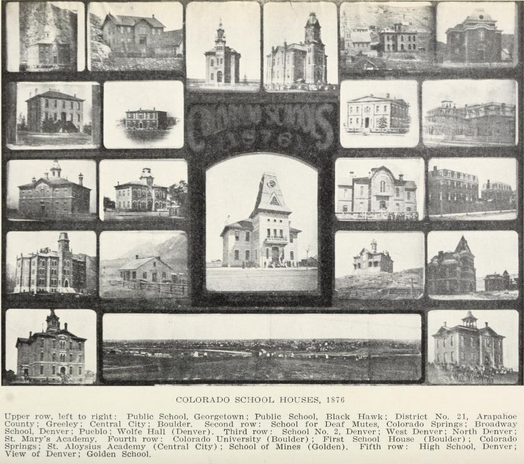What was the first school organized in Colorado, and who was the first teacher? Where was the first schoolhouse? What was Colorado’s first taxpayer-supported public school system? These and many other questions about Colorado’s early education system can be answered in chapter 22 of the five-volume History of Colorado, 1927, available online from our library. The education chapter begins on page 1149 of Volume 3.
This publication, published by the State Historical and Natural History Society of Colorado (today known as History Colorado), was edited by their well-known historian LeRoy Hafen along with University of Colorado President Emeritus George Baker; individual chapters were contributed by subject-matter experts. The education chapter is written by Thomas J. Mahan, an education professor at the State Teacher’s College (today’s University of Northern Colorado in Greeley). Mahan’s previous experience included serving as a school principal in Leadville and as a high school teacher in the Philippines. (Volumes 4 and 5 include short biographies on hundreds of Coloradans, so if you’re researching a Colorado notable from prior to 1927, History of Colorado is a good place to start. Mahan’s bio is on page 229 of Volume 5).
So what were Colorado’s education firsts? Mahan first reminds us that long before whites had established formal schools, the American Indians who inhabited the region had their own system of education and training. However, regarding formalized (white) education systems, Colorado’s first official teacher is considered to be Owen J. Goldrick, who established the first school on October 3, 1859, in the town of Auraria (now part of Denver). Known as Union School, it did not have its own building, but rather the students met in “the room lately occupied by Colonel Inslee.” The first school to have a building constructed specifically for the purposes of education was not in Denver, but in Boulder. In the summer of 1860, Boulder was a little town consisting of a handful of cabins and two general stores. When a trained teacher, Abner Brown, arrived in town, he inquired about the number of children in the town and found it to be around forty, enough to start a school. With the help of local residents, Brown constructed a cabin for a schoolhouse, and built the desks and furnishings, as well. The little school served the community until 1872, when a larger building was needed.
 |
| Schoolhouse built by Abner Brown in 1860, from History of Colorado, volume 3. |
Goldrick’s, Brown’s, and other early schools were funded by subscription, meaning they were paid for by the families of the students, while sometimes supplemented by voluntary contributions from community members. The first taxpayer-funded public school system, however, was established in 1862. That year, two public school districts were formed in Denver, one in East Denver known as District One, and one in West Denver known as District Two. Each district had its own elected board. Mahan’s chapter quotes the Rocky Mountain News, which on December 16, 1862 reported that “‘our public schools are now in successful operation.'” (Today, Denver Public Schools are a single citywide system with one school board.)
You can find many more resources on the history of Colorado education by searching our library’s online catalog. In addition to Mahan’s history, be sure to view the annual/biennial reports of the Superintendent of Public Instruction, which our library has digitized for 1874 through 1964.
 |
| This photo collage from History of Colorado, volume 3, shows the various school buildings in Colorado prior to 1876, the year Colorado became a state. |
- How to Spot the Differences Between Eagles and Hawks - August 16, 2021
- How Transportation Projects Help Tell the Story of Colorado’s Past - August 9, 2021
- Time Machine Tuesday: The Night the Castlewood Canyon Dam Gave Way - August 3, 2021
